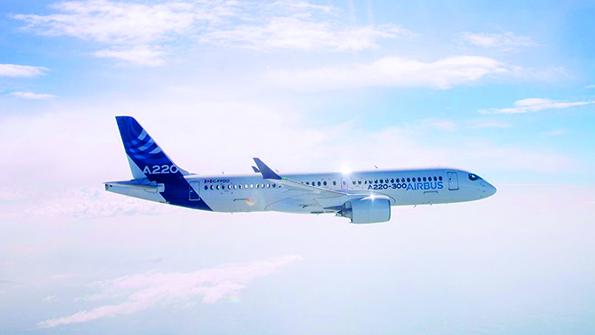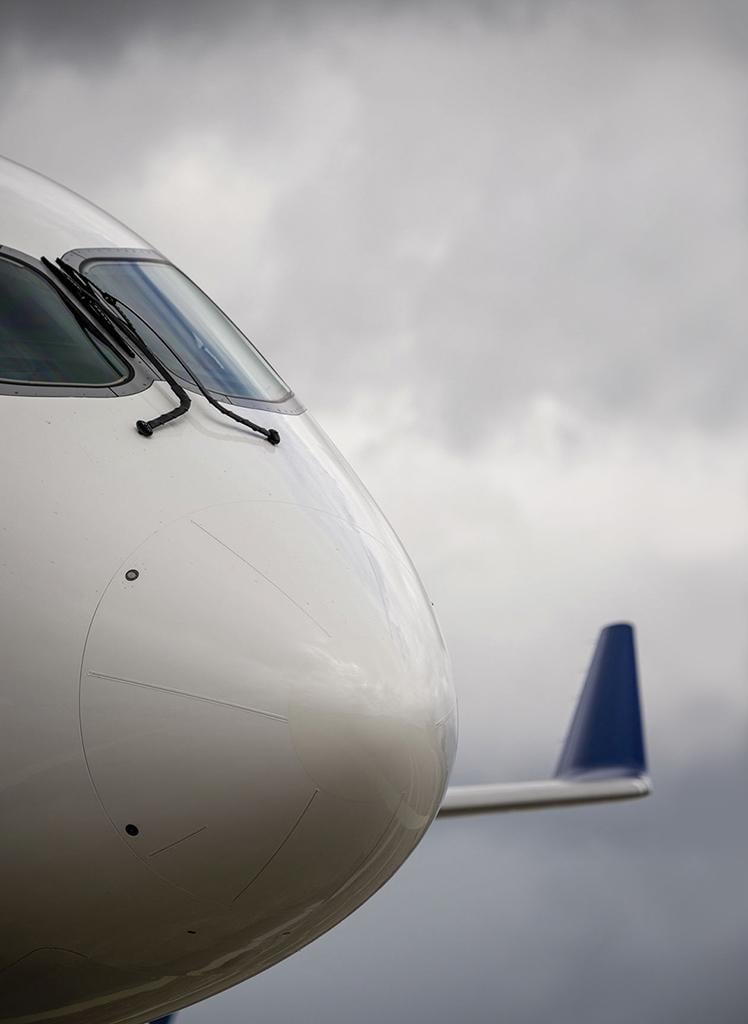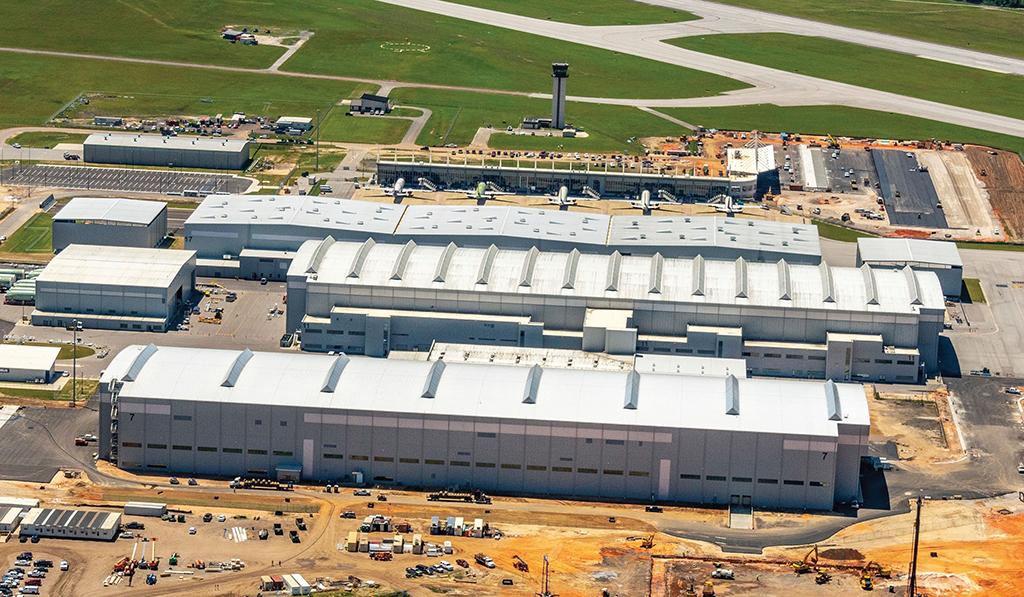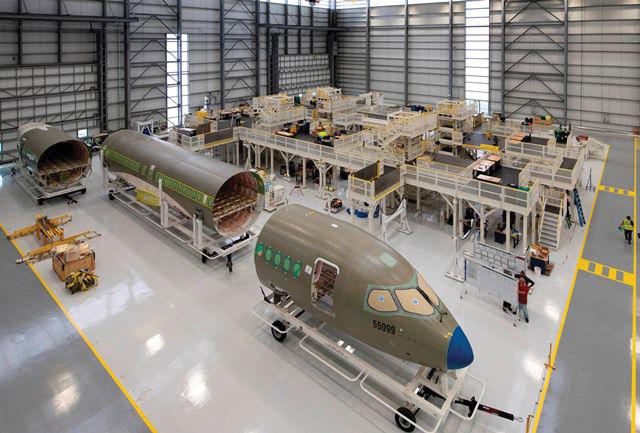Airbus A220 Role May Grow In Post-Pandemic Air Transport | エアバスA220、コロナショック後の航空業界で存在感を増すことができるか

エアバス社が2017年にボンバルディアCシリーズを実質的に損失分担保証だけで入手したとき、大半のアナリストはこの動きを手放しで称賛した。彼らは、この契約により、この先何年もエアバス社がボーイング社に対して戦略的に優位に立つことになると感じていたからだ。
Aviation Weekはエアバス社によるこの契約を「世紀の契約」と称した。今ではA220プログラムと呼ばれている、同機に関するボンバルディア社の残りの株式をエアバス社が取得したことは、この機体が持つポテンシャルを考えれば極めて自然な成り行きだと思われていた。
しかし、新型コロナウィルスが世界と航空業界を一変させてしまった。この巨大なリセットは、事実上業界のあらゆる領域に影響を及ぼしている。
今日における最先端のナローボディ機ですら、その影響を大きく受けている。この契約の戦略的な意味合いや、長期的にはポジティブな見通しは変わらないものの、当初のビジネスプランはもはや過去のものとなり、見直しが必要になった。コロナ危機は、A220プログラムが本格的に始動しようとした矢先に襲いかかった。少なくとも短中期的には、エアバス社が思い描いていた役割を果たせるかどうか、不確実な状況だ。

2019年にエアバス社は初期の生産数を月産4機に設定し、これに合わせる形で48機のA220をデリバリーした。当初の計画では、これを可能な限り早く増やしていく予定だった。これには2つの理由があり、2025年までにプログラムを黒字化するため、そして政治主導でアラバマ州モービルに開設され、5月に稼働した2つ目の最終組立ラインの存在を正当化するためだ。
しかし、実際には正反対のことが起きた。同社は2020年8月までにわずか13機しかA220をデリバリーできていない。年末までにデリバリー数が急増でもしない限り、このプロジェクトに対する最も悲観的な生産量予測すら下回ることになるだろう。
ケベック州ミラベルにある組立ラインは、州政府の指示により3月末から5月にかけて7週間閉鎖された。現在、このラインでは月産3機を生産中で、2021年中頃には月産5機に拡大される予定だ。これは当初計画の1年遅れとなる。モービルの組立ラインでは月産1機を生産中だ。
2つの工場の生産能力を合算すると、月産14機の生産能力がある。ミラベルで10機、モービルで4機だ。この生産能力は、必要に応じてさらなる投資を行うことで拡大することもできる。エアバス社としては今後5~6年で月産14機体制を整えたいとしているが、「コロナ危機の影響を考慮しつつ、今後数年でマーケットが拡大した場合に実施される」としている。
コンサルティング会社Avitas社の上級副社長・Adam Pilarski氏は「この生産数は妥当なものだ。生産能力の拡大は実現可能であり、実際に試みるべきだ。私はエアバス社の計画を信頼している。これは簡単に1,000機規模のプログラムに成長するだろう」と語る。
2020年にはデルタ航空が3機のA220-100を受領し、ミラベル工場からさらに10機がエアカナダとエジプト航空にデリバリーされた。なお、コロナ危機以前から、エアバス社の販売戦略にとっての課題は、予定されているミラベル工場の生産量拡大、もしくは最低でも将来にわたり生産量を維持し続けるために、アメリカ国外に充分な顧客を確保ことだった。しかし、ミラベルおよびモービルでの生産量拡大はおろか、現状を維持することすら、予断を許さない状況となっている。
もうひとつの問題は、ごく一部のアメリカ顧客への依存度が非常に高いことだ(特に今後5年間)。Aviation Week Intelligence NetworkのFleet Discoveryデータによれば、ジェットブルー・デルタ航空・ブリーズ航空(David Neeleman氏のスタートアップ企業)が、モービル工場が受け持つ主要顧客3社だ。 この3社合計で、2021年に26機、2022年に40機、2023年に52機、2024年に44機がデリバリーされる予定となっている。

一方のミラベル工場も、今後4年間でエアカナダ・エアバルティック・エールフランスの3社に依存することになる。しかし、3社合計で65機という機数は、たとえ生産レートを大幅に下げたとしても、工場の生産能力を満たすには程遠い。Fleet Discoveryデータによると、エアカナダは2023年までに残り37機のA220を受領予定で、うち27機が2021~2022年に予定されている。エアバルティックでは28機の確定発注が残されているが、最近になって最終機のデリバリーを2024年に延期した。最初に発注された50機の最終機は2023年末にデリバリーされることで合意している。エールフランスは2021年にまず5機を受領し、2022~2024年は毎年14機を受領する。
エアリース社は2019年に50機のA220-300を発注したが、大部分は2025年以降の納入予定だ。生産はミラベル・モービルの両工場で分担される可能性もある。
A220は競争力のある機体だ。事実上、唯一の競合はエンブラエル社のE2シリーズのみだが、同社はボーイング社と予定していた提携計画の破綻により弱体化している。機体規模の観点からE2と競合するのはA220-100だ。座席配置にもよるが、同機はE190-E2とE195-E2の間に位置することになる。ただし、最大離陸重量は63トンと、E190-E2(56.4トン)を大きく上回り、E195-E2(61トン)よりも大きい。さらに、航続距離も3,400nmと、E190-E2の2,800nmやE195-E2の2,600nmよりも長い。
これらの機体は、表面上は競合しているものの、実際には異なるマーケットに対応している。A220-100はニッチな機体で、多くのオーダーは低需要の長距離路線に対応する、より大型の-300に集中している。航空会社にとって、最大離陸重量が大きい機材を短距離路線に用いることは、コスト面で不利になる。ヨーロッパやアメリカにおける従来からのリージョナル路線であれば、基本的にはE2の方が適しているだろう。ただし、E2シリーズ最小のE175-E2を含め、スコープ・クローズの制限には収まらない。とはいえ、それはA220も同様だ。

より大型のA220-300に匹敵する座席数・航続距離のモデルはE2シリーズには存在しない。エアバス社は航続距離を4,000nm程度に延ばしたモデルの開発も進めており、これが実現すれば大西洋横断路線や、アメリカと南米を結ぶ路線にも投入することができる。しかも、A220はさらにストレッチさせることも可能で、すると今度はボーイング737-7および-8のマーケットをカバーできるようになる。
様々な違いがあっても、いずれにせよ競合が生じることは間違いない。現実には、一部の航空会社はA220の航続距離を必要としないにも関わらず運航している。その理由のひとつは、エアバス社はA220の契約を他機種(A320neoなど)と組み合わせることができるからだ。エンブラエル社がボーイング社との提携を目指したのも、このような形で同様のラインナップを提供することが狙いだった。
航空会社各社は、小型機を中心に運航することで料金や収益リスクを抑えることに注力しているため、A220やE195-E2はコロナ禍からの回復に貢献すると主張されてきた。エアバス社によると、A220フリートの80%が7月までに運航を再開しており、100%の再開に向けてこの傾向は続くとしている。
しかし、それが必ずしも将来の販売につながるとは限らない。機材の追加発注に投資できるような航空会社はほぼ存在しないからだ。エアバス社のCEO・Guillaume Faury 氏さえ、航空会社の回復に伴い、早ければ2022年にも「かなり急激な増産」が実現すると考えていると最近コメントした。このような急成長が実現するシナリオにおいて、航空会社の経営陣は引き続きリスク回避に注力するのか、それともシェア争奪戦を再開することになるのだろうか?
以上は、Jens Flottauが Aviation Week & Space Technologyいた記事です。A320neoやボーイング737-8と競合するA220-500の開発にエアバス社が乗り出すのかどうか、その議論の詳細はフルバージョンの記事でお読みいただけます。
When Airbus acquired what was then called the Bombardier C Series in 2017 for essentially nothing plus guaranteed loss-sharing with the Canadian company, most analysts were full of praise for the move. They felt it would put Airbus in a much better strategic position vis-a-vis Boeing for years to come.
Aviation Week called the transaction Airbus’ “deal of the century”. And when Airbus decided to take over the remaining stake Bombardier held in what is now called the A220 program, it was seen by most as a natural decision, given the aircraft’s potential.
But now COVID-19 has changed the world—and with it, air transport. The big reset affects essentially all aspects of the industry.
Even the most modern narrowbody available today is suffering enormously from the impact. And though the strategic rationale for the deal and the positive long-term outlook for the program itself remain, the original business plan for the A220 is history and needs to be rewritten. That realization has come just as the program was about to take off in earnest. There are ample uncertainties about whether it can fill the role that Airbus envisioned, at least in the short and medium term.
In 2019, Airbus delivered 48 A220s, in line with the initial baseline production rate of four aircraft per month. The plan was to take it upward as fast as possible from there, both to have the program profitable by 2025 and to justify the politically driven introduction of the second final assembly line in Mobile, Alabama, which officially opened in May.
What happened, of course, is quite the opposite. In the first eight months of 2020, Airbus delivered only 13 A220s. Unless there is a sudden spike in deliveries between now and year-end, Airbus will fall short of even the most pessimistic analyst projections for the program.
The Mirabel, Quebec, assembly line was closed for seven weeks from late March and into May following a Quebec provincial government order. The line is now producing three aircraft per month and is going to five by mid-2021, one year later than planned. Mobile is building one aircraft per month.
Combined, the two production centers have a capacity of 14 aircraft per month: 10 in Mirabel and four in Mobile. That capacity could be expanded further with more investment should that be needed. Airbus is keeping to its target of expanding output to 14 by mid-decade but cautions: “This could be adapted as the market evolves over the coming years and in the context of the COVID-19 crisis.”
“The production numbers are reasonable,” says Adam Pilarski, senior vice president at consultancy Avitas. “They can and should try to ramp it up. I have confidence in the Airbus plans. . . . [It can] easily be a 1,000-aircraft program.”
In 2020, Delta Air Lines has taken three A220-100s; 10 additional aircraft went to Air Canada and EgyptAir and were delivered from the main base in Mirabel. Even before the novel coronavirus pandemic hit, Airbus’ main sales challenge for the A220 was to find enough customers outside the U.S. to either enable the planned Mirabel ramp-up or at least sustain the existing rate well into the future. The prospects of resuming growth, or even sustaining rates—both there and in Mobile—are not good for the foreseeable future.
Another issue is the high dependence on just a few U.S. customers, particularly for the next five years. According to the Aviation Week Intelligence Network Fleet Discovery database, JetBlue, Delta and David Neeleman’s start-up Breeze Airways are the three main customers for the Mobile line. In 2021, the three are due to take a combined 26 aircraft, then 40 in 2022, 52 in 2023 and 44 in 2024.
Over the next four years, Mirabel is planned to depend on three large customers—Air Canada, AirBaltic and Air France—but their combined backlog of 65 aircraft is not nearly enough to fill production capacity, even at much-reduced rates. Air Canada is due to take delivery of 37 remaining A220s through 2023, 27 of them planned for 2021 and 2022, according to Fleet Discovery. AirBaltic has 28 more aircraft on firm order and recently decided to stretch deliveries into 2024. The last of 50 aircraft originally were agreed to arrive at the end of 2023. Air France is slated to take five aircraft in 2021, rising to 14 each year in 2022-24.
Air Lease Corp. placed an order for 50 A220-300s in 2019, but the bulk will arrive only from 2025 onward. Production could be split between Mirabel and Mobile.
The A220 is well-positioned competitively. Its only real competition is the Embraer E2—and Embraer is further weakened after the collapse of the planned commercial aircraft partnership with Boeing. The A220 version that does compete with the E2 in terms of size is the -100. Depending on cabin layout, it sits somewhere between the E190-E2 and the E195-E2. However, at a maximum takeoff weight of 63 tons, it is much heavier than the E190-E2 (56.4 tons) and even the E195-E2 (61 tons). And it has a lot more range: 3,400 nm versus 2,800 for the E190-E2 and 2,600 for the E195-E2.
While they are competing superficially, the types really address different market segments. The A220-100 is a niche aircraft—most of the A220 orders are for the larger -300 version—suitable for long, thin routes. Airlines pay a cost penalty when they use it on shorter routes in spite of its weight. More traditional regional connections in Europe or the U.S. are better served with the E2 in principle, though none of the E2 versions including the smallest E175-E2 is compliant with scope clause limitations. But neither is the A220.
The larger A220-300 is effectively beyond the range of the E2. This is true not only in terms of size but also, literally, range. Airbus is working on versions of the aircraft that would extend the range to around 4,000 nm, making it capable of flying across the Atlantic or deep into Latin America from the U.S. But the A220 is also well-positioned to be stretched further, to cover what is now the Boeing 737-7 and -8 market.
Despite the differences, there will nonetheless be competition. The reality is some airlines are operating the A220 even if they do not need its range, in part because Airbus can combine A220 deals with other models such as the A320neo. That is why Embraer tried to tie up with Boeing and offer a similar portfolio of aircraft.
It has been argued that the A220, and the Embraer 195-E2 for that matter, will benefit in the COVID-19 recovery as airlines focus on minimizing trip costs and revenue risk by flying smaller aircraft. Airbus says 80% of the A220 fleet had returned to service by July—with the trend continuing, essentially toward a complete return.
But that does not necessarily translate into future sales, as few airlines are currently in a position to invest in more aircraft. Even Airbus CEO Guillaume Faury recently commented that he believes that a steep, “quite brutal,” ramp-up in production could arrive as early as 2022 as airlines rebound. In such a scenario of fast catch-up growth, will airline executives focus on risk containment, or will it be all about market share again?